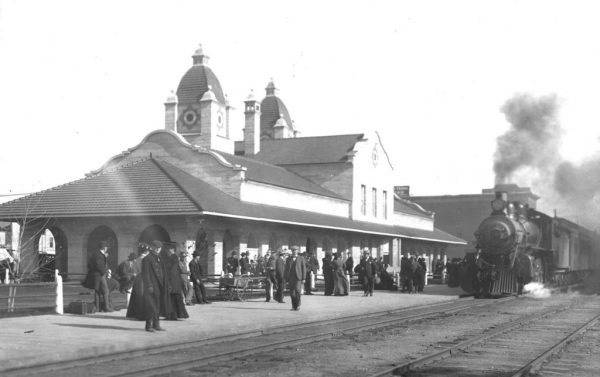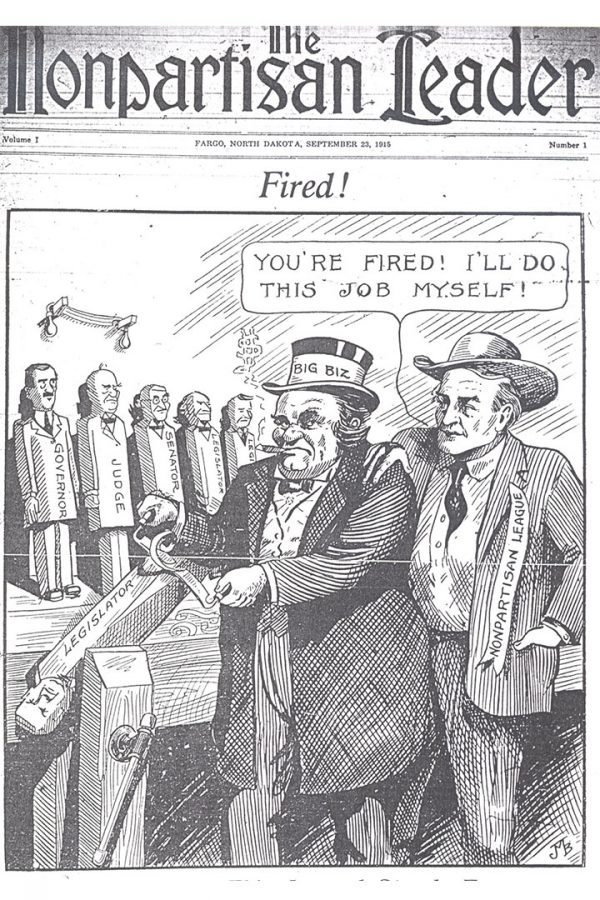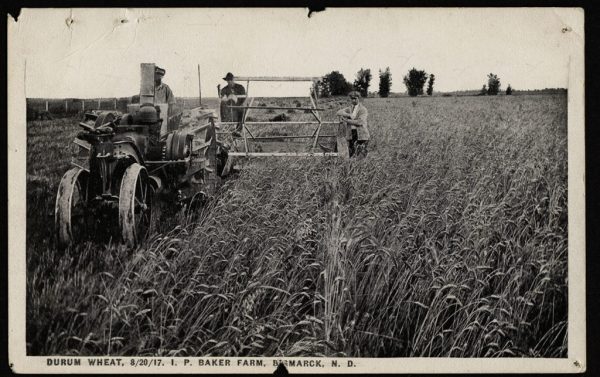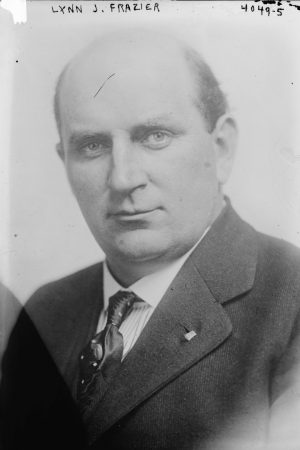NOTE: 2019 marks 100 years since the founding of the US’ only public bank, the Bank of North Dakota. They published the story of the bank here. We will bring you an installment of that story each week.
1915 – 1919
The Case for a State-Owned Bank
The credit system of the United States and the northern plains was not structured to meet the needs of North Dakota farmers in 1915. National banks could not lend money on farm mortgages. State banks could make farm loans, but they were under-capitalized, often dependent on money from out of state.
Farmers were heavily dependent on store credit—buy food and hardware on credit now, pay for it after harvest—and insurance companies. Farmers needed money to purchase equipment, buy seed and livestock, and pay for such necessities of life as they could not produce for themselves on their farms. Commercial interest rates in the state were high—significantly higher than national averages. Local bankers were sometimes hostile or indifferent. Even those who were sympathetic found it nearly impossible to provide farmers loans at a price they could afford.
The credit situation in North Dakota was not merely a strain on family farmers. In thousands of cases, it made it impossible for the farmer to get in or harvest a crop.
Something had to change.

There were only three options: Persuade commercial bankers to be more helpful and understanding; create some sort of rural credit banks that would lend money to farmers at cost or at below-market rates (a sort of credit union approach); or create a central state bank for North Dakota that would make loans directly to farmers or at least induce local commercial banks to assume a more helpful policy in dealing with the cash-starved farms of North Dakota.
In addition to the banking challenges, the railroads were charging higher rates to transport grain within the state than to transport more miles to elevators in Minneapolis and Chicago. Elevators charged unfairly high prices to store the grain of North Dakota farmers, creating a perfect storm for dissatisfaction and frustration among farmers.
The Birth of the Nonpartisan League
The Nonpartisan League was born on a farm near Deering, North Dakota. In February 1915, A.C. Townley appeared at the farm of Fred B. Wood to pitch the idea of a new political movement that would not be tied to the Democratic, Republican or Socialist parties. Wood and Townley had met earlier in Bismarck. At that time Wood invited Townley to come to his farm in the spring after the snow melted.
The always-restless Townley did not wait for spring. The two men talked deep into the night. Wood was at first skeptical, but Townley’s unrelenting enthusiasm finally convinced him. After several days of passionate talk, the two men scribbled out a League platform on a scrap of wrapping paper by the light of a kerosene lamp. The next morning, they steered a bobsled to neighboring farms. Fred Wood performed the introductions, Townley made the pitch. The combination was extremely effective. Eventually the Nonpartisan League gained more than 100,000 members in North Dakota. Four years after its formation in west-central North Dakota, the League had entirely taken over the state government of North Dakota.
As it was originally envisioned, the League’s program would create a statewide network of socialist institutions: rural credit banks scattered throughout North Dakota, along with packing and cold storage plants. In addition to one large terminal elevator to be located out of North Dakota (at a national shipping port), a series of local elevators and flour mills would be established within the state to give farmers a viable local alternative to commercial elevators that took their marching orders from railroads, Minneapolis banks and milling interests. Mandatory state-provided hail insurance would provide every farmer coverage at substantially lowered costs.
The Original Platform of the Nonpartisan League
- State ownership of terminal elevators, flour mills, packing houses and cold-storage plants
- State inspection of grain and grain dockage
- Exemption of farm improvements from taxation
- State hail insurance on the acreage tax basis
- Rural credit banks operated at cost
In the original program, the state’s severe credit problems would be solved by rural credit banks, not (yet) a central State Bank of North Dakota.

Nonpartisan League Gains Support
Farmers were paying up to 12% interest. Grain elevators graded grain as lower quality and farmers lost up to $55 million each year. Rail cars were poor quality, losing grain along the way. Farmers were paid based on the delivered weight. To transport 60,000 pounds of wheat from Minot to Grand Forks, a farmer was charged $91.80; Moorhead to Minneapolis which was 45 miles further was $61.80. These economic realities served as good fuel to the NPL fire.
An organizing machine
Townley and his cohorts attempted to organize the farmers of North Dakota before opposition could be developed. Many of the newspapers of the state were caught off guard. Because they regarded themselves as the natural clearing houses for all developments in their districts, most of those newspapers responded with skepticism or open hostility. With little solid information in their hands, they groped in the dark to try to understand what was happening in the rural countryside. The Kidder County Ozone’s response is typical:
“Recently the Ozone referred to the presence in the state of a number of solicitors for membership in some kind of ‘party’ which was to be of special advantage to farmers, and who also offered a year’s subscription to some paper or magazine as material inducement for joining. A fee of $6 was collected from each subscriber … It is more than ever evident that the farmers who took stock in the smooth strangers were too easy victims of a confidence game. In no case have the strangers sought to interest anybody in towns where they have stopped, and it has been noticed that in making even a trifling purchase they always tender $6 checks, cashing them in that way. They never go to a bank … As before stated, the Ozone believes, with the Fargo newspapers, that this is only a scheme for fleecing the unwary … Our belief is that they are operating a questionable scheme, as there is no public knowledge of such a farmers’ protective party as they affect to represent, and their avoidance of association or contact with townspeople, and advance dating of checks are suspicious.”
One of the League’s most effective organizing tactics was the use of the post-dated checks. Townley rightly understood that farmers would only remain committed to the League and its program if they had “skin in the game.” But most farmers did not have enough ready money to pay for their League dues. Townley instituted the use of post-dated checks, to be cashed after harvest, so that each farmer would invest in the League at the time of his recruitment, before the spell of the salesman’s charisma wore off. Although many commercial banks refused to honor these checks, and though some farmers canceled payment after the initial intoxication of Townley had dissipated, the League’s use of this organizing tactic made a huge, arguably, essential contribution to the early success of the Nonpartisan League (NPL).
The Nonpartisan Leader

Townley understood that once the League began to seem like a viable political movement, opposition would be fierce, well-funded and ruthless. He knew that most newspapers in North Dakota would side with the established order. Almost immediately, therefore (September 1915), Townley and the League launched the Nonpartisan Leader, a lively, provocative, well-edited weekly League newspaper, headquartered in Fargo. Soon the League purchased its first daily, the Fargo Courier-News. The League also organized something called the Northwest Publisher’s Service to purchase local weekly papers and to coordinate the League’s plan to designate official newspapers (friendly to the League) in every county of North Dakota. The Northwest Publisher’s Service was one of the most controversial innovations of the NPL.
The NPL in Minnesota
In neighboring Minnesota, Charles A. Lindbergh (the father of the famous aviator) ran for governor on the NPL ticket in 1918. During one rally, his driver was roughed up by an anti-League mob until Lindbergh personally intervened. As the League cohort left the grounds, bullets were fired at their automobile. Lindbergh insisted that they drive away slowly to make it appear that they were not frightened by the violence. They were frightened, of course, but Lindbergh insisted that rushing away would only encourage further mob violence.
Public Perceptions

The League’s stunning success in the 1916 elections in North Dakota brought journalists from all over the United States to the legislative session of 1917. Many made fun of the “rubes” and “yokels” who now controlled the North Dakota House of Representatives and dismissed them as “tools” of “Boss Townley” and his henchman William Lemke. William MacDonald of The Nation, however, was surprised and impressed:
The farmer legislators, he wrote, were “…neither visionary theorists nor wild-eyed radicals… I have seldom observed a State legislature whose controlling majority was so obviously sensible, moderate and intelligent. The extremist of every type, the voluble expounder of radical notions, or the reformer with his one all-sufficnet remedy for social ills, was conspicuously absent.”
Name Calling
Supporters of the Nonpartisan League were called many things: “red Socialists,” “expert hypnotists,” “gold brick vendors,” “world revolutionaries,” “atheists,” “IWWs,” “dynamiters,” “free lovers,” “carpetbaggers,” “home wreckers,” “Huns,” “traitors,” “noisemakers,” “theorists,” “dilettantes,” “dreamers,” “beautiful phrasemakers,” “swivel-chair reformers,” “mild-eyed poets,” “sweet-mouthed flatterers,” “mountebanks,” “confidence men,” “anarchists,” ”charlatans,” “agitators,” “visionaries,” …
Minnesota judge John F. McGee said, “a Nonpartisan League lecturer is a traitor every time. In other words, no matter what he says or does, a League worker is a traitor.” Judge McGee said what Minnesota needed was a few “necktie parties.”

Some of these epithets were ludicrous and profoundly unfair. A few had a kernel of truth. But they all indicated that the opposition was more interested in name calling than in a serious debate about how to address the fundamental economic and political issues of North Dakota. The “dynamiters” and “noisemakers” were actually just family farmers trying to get a better price for the food they grew to feed the people of America.
The League platform
The League program was virtually identical with the program of the North Dakota Socialist Party: a system of state enterprises, including a terminal elevator and flour mill, rural credit banks, state hail insurance, state-owned packing houses and cold storage plants; plus, reform in grain weighing and grading practices, and the exemption of farm improvements from taxation.
What the League offered was a moderate program of socialism without the Socialists. Most of the farmers of North Dakota were sensible pragmatists, not ideologues. North Dakotans did not want to be labeled as radicals, subversives, or members of the Socialist Party, but-–it turns out—they were not afraid to embrace a handful of “socialist” solutions to their chronic economic problems.
Key Leaders For The Nonpartisan League

A.C. Townley was a gifted rabble rouser, a talented political strategist, and, in the opinion of many, a demagogue. He was also a genius. After plunging into a bonanza flax farm north of Beach, North Dakota, and losing everything, Townley became a field organizer for the small North Dakota Socialist Party.

Lynn J. Frazier (1874-1947) was a farmer at Hoople, North Dakota, in Pembina County. Educated at the University of North Dakota, Frazier had never intended to take over the family farm, but the early deaths of his father and brother forced his hand. He had planned to be a doctor. He had taken on a few civic responsibilities in Hoople, including the school board.

William F. Lemke (1878-1950) was considered by many to be the brains of the Nonpartisan League. He was called “the political bishop” by some. He had known Bill Langer before the League was founded. He was practicing law in Fargo when he was recruited for leadership in the NPL in the summer of 1915.
Ironies
Although the farmers of North Dakota had risen to reclaim their destiny from determined “bosses” who lived in Minneapolis or Chicago, they were soon enough led by two individuals, A.C. Townley and William Lemke, who almost immediately moved their headquarters from Fargo to St. Paul, and spent much of their time dictating policy to Governor Frazier in Bismarck or instructing League legislators about how they should respond to every emerging political development. These leaders disavowed the idea that they were new political czars, that they were dictating strategy to the farmer legislators; they explained that farmers with no previous political experience not only needed but welcomed political advice from more seasoned leaders.
Townley and Lemke were accused of being dictators from the beginning of the Nonpartisan movement. Although the accusations were designed to discredit the League, there was a significant measure of truth in the view that Townley regarded himself as the undisputed director of the League. Lemke was clearly subordinate to Townley, but his own will to power was such that it could be argued, and was, that the people of North Dakota had removed one set of political czars only to replace them with another. The optics of the move of the League headquarters to St. Paul helped critics undermine the NPL’s credibility.
As Blackorby writes, “Although the League had rebelled against the Twin City rule of Alexander McKenzie, League leader Lemke was now doing part of the governing from the Twin Cities.”
Disruptive Technologies
At the time of the Nonpartisan League’s founding, North Dakota had a weak infrastructure. The 620,000 citizens of North Dakota were evenly distributed over a vast, largely undifferentiated prairie landscape. Fargo, the largest city in the state then and now, had a population of about 16,000 in 1917. Townley realized that it would be impossible to take over so vast a countryside without the help of emerging technologies.
At first, he used Model T Fords, including one that he borrowed from League co-founder Fred Wood of Deering. Soon a fleet of Model Ts fanned out across North Dakota, beginning in the west.

In the pivotal 1916 gubernatorial election, the League’s candidate Lynn J. Frazier toured North Dakota on a Frazier Special train. This enabled him to meet more people and give more speeches than would have been possible in any other way. Ironically, Frazier harnessed the hated Northern Pacific and Great Northern Railroads to decry North Dakota’s colonial status.

In 1921, barnstorming the state to oppose the recall election and initiated attempts to dismantle the League’s economic program, Townley flew in an airplane. Thus the “agrarian savior” literally descended from the sky to address large audiences all over the state. At the time, most North Dakotans had never witnessed the flight of an airplane. The effect was electrifying.
The Birth of the Bank
Nobody is quite sure where the idea of a state-owned Bank of North Dakota came from. League officials, including Governor Lynn J. Frazier, had spoken frequently of “a system of rural credit banks operating at cost,” (a kind of rural credit union system), but the idea of a central state bank did not enter the discourse until 1918 and 1919. A booklet published by the League on August 31, 1918, called for a “State Bank which will act in a similar capacity for our state as does the Federal Reserve and Farm Land Banks. . ..”
Conservative representative Paul Johnson of Mountain, North Dakota, wrote, “The bill looks to me to be socialist in the main points. I do not believe in state-owned and operated utilities: at least I do not believe in experimentation on a large scale like this.”
The 1919 North Dakota legislative session, taking its cues from the Nonpartisan League’s Industrial Program for North Dakota, created the Bank of North Dakota. The legislation declared that the Bank was “created for the primary purposes of providing low-cost rural credits, financing state departments and enterprises, and serving as a clearinghouse and rediscount agency for banks throughout the state.”

The NPL prepared a memorandum of recommendations during the 1919 session and presented it to the House and Senate of North Dakota. Article 7 said: “That the state should establish and operate its own bank, for the financing of all state departments, industries and enterprises, for the handling of all public funds and for the making of farm loans and the stabilizing of credit in all industries carried on in the state.” This was the founding document of what became the Bank of North Dakota.
In the end, the League program was reduced to one large state mill and elevator (in Grand Forks), and one state bank (Bismarck). This centralization of what was originally a vision of a myriad of decentralized banks, elevators, and mills undoubtedly reduced the effectiveness of the monumental entities, but-–ironically—they probably insured their survival. It seems certain that the decentralized array of smaller institutions would have been swallowed up by the dynamics of North Dakota history. The two central institutions—the State Bank and the ND Mill and Elevator—were, in a sense, too big to fail, or at least too big to for League enemies to kill off with impunity.
After the landmark ND legislative session of 1919, even the hostile Grand Forks Herald wrote:
“The session was the most important in the history of the state, and it accomplished the most far reaching legislation yet enacted. The state is now the socialistic laboratory of the country, and unless the people veto the administration measures the experiment soon will begin… The most interesting experiment in the history of the country will be carried out in this state during the next two years.” The Herald concluded, “There is nothing Bolshevist, so far….”
The original guiding principles of the Bank of North Dakota

The Bank could transfer funds to other departments, institutions, or enterprises of the State of North Dakota.
The Bank could make loans to political subdivisions or to state or national banks.
Loans to individuals, associations, or corporations must be secured by mortgages on real estate or warehouse receipts.
The Bank of North Dakota was to be examined by state examiner twice per year followed by a report to the Industrial Commission and the North Dakota Legislature.
An initial $100,000 was appropriated to establish the Bank.
The Bank could commence operations as soon as it received $2 million from sale of state bonds authorized for capital.

Opposition to the Bank
The idea that simple farmers could chart their own destiny and win honest election to the highest offices in North Dakota appalled establishment institutions not only in North Dakota but across the United States. It was unthinkable that farmers had the intelligence, the political instincts and talent, and the organizational skills to change the trajectory of life on the northern Great Plains. Instead of debating the merits of the League’s Industrial Program, most institutions, including newspapers, fought the battle with sarcasm, condescension and ad hominem attacks. The Dayton Press, located in Washington state, wrote,
“No wonder that the Nonpartisan bunk became so popular in North Dakota. The census taker found only five bathtubs in four counties. Uncleanliness and ignorance are ever companions, instance the Bolsheviki in Russia and the Bolsheviki hoboes of the I.W.W. and other unclean classes in the United States.”
The most forceful of the attacks on the Nonpartisan League were that it was the vanguard of a socialist movement designed to imitate in America the goals and methods of the Bolshevik Revolution in Russia, and that its leaders showed disloyalty at a time of international emergency. The NPL endorsed the American war effort in World War I, but reserved the right to question the aims and actions of the United States. Although the League at different moments imagined a fairly wide number of state-owned economic enterprises, some of them seemingly frivolous, it never intended or suggested a Socialist Revolution. The State Bank of North Dakota is one ”socialist” legacy of the NPL movement.
Referral
In the wake of the revolutionary 1919 legislative session, the Independent Voters Association (IVA) referred several bills, including the creation of the Industrial Commission, the establishment of the Bank of North Dakota, the law providing for the selection of official newspapers in every county, the bill funding a Commissioner of Immigration, and other legislation.
Governor Lynn J. Frazier pre-empted the IVA plan by calling for a statewide referendum on the seven major pieces of League legislation for June 26, 1919.
After a bitter campaign, in which the IVA lied repeatedly to the people of North Dakota, the seven measures were all affirmed by the people.
The Bank of North Dakota was re-affirmed by a 23,256-vote majority.

Taking Matters Into Their Own Hands
The farmer citizens of North Dakota wanted to address certain serious problems of North Dakota economic and political life—exploitation of the people by out-of-state entities, such as banks, railroads, elevators and milling companies. They had long believed that a terminal elevator, probably located elsewhere but perhaps in North Dakota, would give them more control of the principal commodity of the state, small grains.
The NPL was the political instrument that addressed these problems. The NPL was not necessarily the ideal instrument, because it was born out of the Socialist Party, which most North Dakotans did not support; and because A.C. Townley was a problematic genius, who brought about the revolution but became a lightning rod because of radical rhetoric and his insistence on complete control of the League. The NPL brought about the state mill and elevator in Grand Forks, state hail insurance, the Industrial Commission, and the State Bank of North Dakota, among other reforms, but only the state mill was widely popular. It had been a key part of the farmer agenda for years before the birth of the Nonpartisan League.
The state-owned Bank in particular was seen by many North Dakotans as a dangerous and unnecessary innovation. The farmer citizens of North Dakota did not really seek a socialist economy; they merely wanted redress of grievances. If reforms could be accomplished without a wholesale economic and political revolution, most North Dakotans would have been more satisfied than they were with what many regarded as the radical agenda of the League.

League mismanagement of some of the new industries, League punishment of its enemies, and certain hints of authoritarianism (the anti-liar’s law, the Committee of Investigation, the state sheriff law, for example) convinced citizens who endorsed much of the League’s program that the NPL was flirting with authoritarianism. Still, even when the conservative reaction recalled Governor Frazier and discredited Townley and others in the League leadership, the people of North Dakota chose to keep the state mill and elevator and the State Bank of North Dakota alive, to give these innovative experiments a genuine chance to improve conditions in the state. Most North Dakotans were willing to give the League the benefit of the doubt on its response to America’s entry into World War I, but at the same time many North Dakotans were uneasy with the League’s lukewarm support for the war once it was declared in April 1917.
North Dakotans established the State Bank of North Dakota to provide a non-commercial alternative to the existing credit system on the northern Great Plains, particularly with respect to agricultural loans. The Bank would provide credit to farms (and later ranches) below the commercial rate of interest, and with a somewhat more flexible protocol of collateral security. Social and economic experiments that would usually fail to find support in the commercial lending arena would be supported by a bank whose mission was to improve the lives of the people of North Dakota with a dedication to service and solvency rather than the maximization of profit. The very existence of the Bank of North Dakota would put traditional commercial lenders and other capitalist entities on notice that the people of North Dakota were prepared to take matters into their own hands and engage in bold social experimentation to improve their lives.

